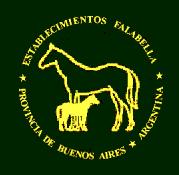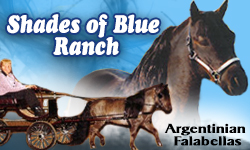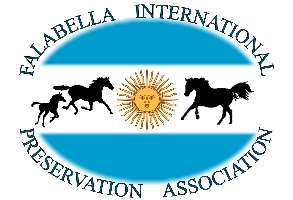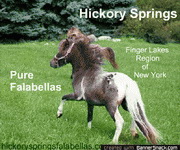|
Origin of the Falabella Breed
Written By: Maria L.B. de Falabella - Buenos Aires, 1991
Like any other breed in the world, the Falabella horse is the product of natural selection -the result of crossing a variety of the Criollo horse with some occasional addition of European and Asiatic breeds- which over time led to a breed with well-defined features, invariably transmitted to the successive generations of horses.
Whenever I am asked about the origin of these horses, I need to refer back to accounts and documents of many centuries ago, when the ancestors of the Falabella horses appeared. I believe that the true origin -based on the similarity of features- dates back to some variety of natural selection whose predecessor was the horse that arrived with the Spanish conquerors of South America.
I would like to make a brief reference to the horses living in this region, on our continent, from which the Falabella horses descended, because they had many virtues that the present Falabellas have inherited.
At the time of discovery of America, the Spanish horses was considered one of the most noble and strongest horse in Europe, with a mixture of Eastern blood from the Moorish horses of Northern Africa and local Spanish breeds. The Spanish horses brought to our lands were likely to have been selected because they were the strongest and most resistant, in order to endure the difficulties and deprivation they would have to face.
After they were brought to our plains "the pampas" the Spanish horses were later abandoned during the unsuccessful first phase of the Conquest, and the imponderable natural selection began. The horses that followed were a product of the struggle to survive in a difficult environment and hence were the strongest. The weakest and organically unfit animals were eliminated by nature, or they were easily captured by the Indians or were prey for the puma.
The strongest and fittest animals capable of surviving became the heads of the herds, and the best of their offspring were chosen by nature to procreate. Even the same consanguinity achieved among the physiologically selected horses should have contributed -as supported by biological laws- to the improvement of the breed, emphasizing the rustic qualities of their parents, and permitting them to thrive in such an environment.
Falabella Breed: Size, Rusticity and Strength
Some of these horses, with the virtues of their ancestors -and for some reason isolated from the rest of the group- may have inhabited a smaller environment, perhaps in the southern hills of the current Province of Buenos Aires. The unavoidable crossbreeding, or some unknown genetic mutation, may have reduced their size steadily and proportionally, a feature transmitted to their offspring.
Undoubtedly the horses already existed by the mid-19th century in that region, when an Irish horse dealer, Newtall, discovered them among a wild herd: a group of tiny and perfectly-shaped horses, the origin of which the local Indians could not explain. They had been among the Indians workhorses for a long time.
Newtall obtained these horses and then bred them of what he once saw in his native country. Soon afterward, he gave his herd to his son-in-law J. Falabella. Since then, the Falabella family -having given its name to the breed- continued to breed the horses and increased the herd size.
By the turn of the century, the blood from other breeds was incorporated in order to refine the proportions of the tiny animals.
The procedure utilized to crossbreed was not recorded and may never be known, but most likely it consisted of the selection of specimens of small stature and manual assistance with copulation.
From one Falabella generation to the next, the morphological and functional selection techniques made it possible to obtain specimens distinguished for their intelligence and small size. Moreover, controlled consanguinity was the means by which the features were fixed and, in 1930, the breed type was achieved and has been maintained to the present.
Breeding and selection has been constant since then, and new methods have been introduced to optimize the results. These techniques and forms of selection are beyond the scope of this review. It should be stressed, that none of these developments could have been possible without the patient efforts of many generations of breeders, including their triumphs and failures. Their hard work has defined the patterns that distinguish the breed, and future generations of Falabella horses will certainly reflect the dedication of those pioneer breeders.
The Falabella Horse Breeders Association
The shared interests of a group of Falabella breeders pursuing common goals resulted in the creation of the Falabella Horse Breeders Association in 1990. Association of Equine Development -with honorary member status- and by the Argentine Undersecretary of Agriculture. Livestock and Fishing. Under my honorary Presidency, the Association has authorities of other nations and foreign horse breeding associations.
Genealogical Studies: Methodology and Origin
The Association maintains genealogical records of the breed, a Registry containing all Falabella horses, as well as records on the provisions and methodology which have been elaborated with the goal of promoting this breed all over the world. As for the origin of the Registry, it may be said that from the very beginning some data was kept about the breed in order to create a chronological record of existing breeding stock. Unfortunately, much of this data disappeared, so that time and the lack of an efficient and permanent, methodology of control left us with no reliable testimony of the very first Falabella.
However, during the 1950s, my husband, Julio C. Falabella (1912-1980), one of the most prominent breeders who contributed to the Falabella's development, compiled -based on old notes and papers held by his family- accurate data regarding some horses born prior to 1920.
The selection processes were later restructured, and services and births controlled, providing the necessary data to establish a methodical genealogical Registry of the Falabella breed.
Julio C. Falabella left an invaluable legacy: his Falabella Establishments. I continued his work with the same devotion, and focused on development of the breed pattern.
The study of documents and other background material obtained through historical research allowed us to determine blood lines and find precise dates for a considerable amount of breed stallions and mares and Falabella offspring, as well as establish a regular schedule of services and branding with Registry serial numbers.
Falabella Establishments also devised a program with specific regulations, based on the morphological and phenotypic features, to register Falabella horses.
I am very grateful for the invaluable and earnest cooperation of local and foreign breeders, professionals and technicians whose contributions made it possible to have formulated specific regulations.
The Registry of the ACCF
Upon the founding of the Falabella Horse Breeders Association, and given ACCF's need to have the necessary elements for maintaining and promoting the breed, the ACCF Genealogical Registry was created based on the Registry ceded by Falabella Establishments to the new entity. The provisions thereof, regarding the breed, authorities and operations of the Registry were drawn up and later approved at an Extraordinary Meeting in 1990.
The association has organized its activities and technical resources in order to ensure the smooth operation of the ACCF genealogical Registry for Falabella horses born in Argentina and their offspring born in this country or abroad.
Maria L.B. de Falabella
Buenos Aires, 1991

|




